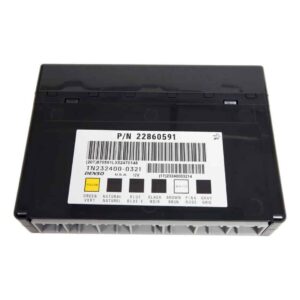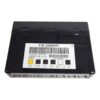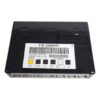Restore Full Electrical Control to Your 2010 Chevrolet Avalanche
Is your 2010 Avalanche acting possessed? Flickering interior lights, power windows with a mind of their own, or a security light that won’t turn off are classic signs of a failing Body Control Module (BCM). The BCM is the central nervous system for your truck’s body electronics, and when it starts to fail, it can cause a cascade of frustrating and unpredictable problems. In my 20+ years of diagnostics, I’ve seen how a faulty BCM can mimic a dozen other issues, leading to wasted time and money on incorrect repairs.
This isn’t just a replacement part; it’s a complete solution. We take the biggest headache out of the repair process by pre-programming this module to your truck’s specific Vehicle Identification Number (VIN). This means you get a part loaded with the latest GM software updates that’s ready for installation right out of the box. No expensive trips to the dealership for programming are required. Just provide your VIN at checkout, and we’ll handle the rest, ensuring a seamless and correct integration with your vehicle’s systems.
A Technician’s Notebook: The Intermittent Gremlin
A customer brought in his 2010 Avalanche complaining of the strangest issues. One day the radio wouldn’t turn off, the next the power locks wouldn’t work, and his battery would be dead every few mornings. He’d already replaced the battery and checked the alternator. After hooking up the scan tool, I noticed communication errors between multiple modules, all pointing back to the BCM. These intermittent faults are textbook BCM failure. Instead of a complex wiring chase, we installed a VIN-programmed BCM. The new module restored stable communication, and all the bizarre electrical gremlins vanished instantly. It’s a powerful reminder that sometimes the most complex-seeming problems have a straightforward solution.
Is Your Avalanche Showing These Symptoms?
- ✔ Unpredictable power window or door lock operation.
- ✔ Interior or exterior lights flickering, staying on, or not working at all.
- ✔ The security system acting up, causing no-start conditions or a persistent security light.
- ✔ Horn honking randomly or not working when pressed.
- ✔ Parasitic battery drain that leaves you with a dead battery overnight.
- ✔ False warning messages appearing on the driver information center (DIC).
Your Straightforward BCM Installation Guide
For the 2010 Avalanche, the BCM is located under the driver’s side of the dashboard, near the steering column. While professional installation is always an option, a confident DIYer can handle this job.
- Safety First: Always disconnect the negative terminal from your vehicle’s battery before working on any electronic components.
- Locate the BCM: Remove the lower dash panel beneath the steering wheel to gain access to the module. It’s a black box with several large multi-pin electrical connectors.
- Disconnect and Remove: Carefully unplug all electrical connectors. They have locking tabs that need to be depressed. Once disconnected, unbolt the old BCM from its mounting bracket.
- Install the New Module: Bolt your new, pre-programmed BCM into place. Firmly reconnect all electrical connectors, ensuring each one clicks securely into its socket.
- Reconnect Power: Re-install the lower dash panel and then reconnect the negative battery terminal.
- Perform Final Procedures: Follow the critical post-installation steps below to ensure full system functionality.
Important: Post-Installation System Resets
After installing your new BCM, a couple of final configuration steps are necessary to prevent warning lights and ensure safety systems are active. These procedures require a professional-grade diagnostic scan tool.
- Airbag System (SRS): To clear the airbag warning light, you must perform the ‘Setup SDM Primary Key in BCM’ procedure. This syncs the new BCM with the airbag system’s Sensing and Diagnostic Module (SDM).
- Brake System: Some vehicles require a Brake Pedal Position Sensor recalibration. This ensures the brake lights and stability control systems function correctly with the new module.
If you are not equipped to perform these steps, a local repair shop can complete them for you quickly.
Verified Vehicle Compatibility
This Body Control Module is a direct replacement for a wide range of General Motors vehicles. Please verify your part number or consult the list below. This unit is compatible with part numbers: 10382479, 15093910, 15276271, 15299986, 15819552, 15828601, 15837419, 15872388, 15872421, 15880684, 15921352, 15921353, 15948438, 15948439, 20815898, 20839063, 20864767, 20864768, 20921435, 20921436, 20935349, 22860591, 25826124, 25826125, 25847588, 25847589, 25892622, 25910474, 25934762, 25934763, and 95151084.
Fitment Includes (but is not limited to):
AVALANCHE 1500 10
CAPRICE 11-13
CAPTIVA SPORT 12
CTS 08-13
DTS 06-11
ENCLAVE 08-12
EQUINOX 07-09
ESCALADE 10
ESCALADE ESV 10
ESCALADE EXT 10
EXPRESS VANS 08-12
G8 08-09
HUMMER H2 08-09
IMPALA 06-13
LUCERNE 06-11
MONTE CARLO 06-07
OUTLOOK 07-10
SAVANA VANS 08-12
SRX 07-09
STS 10
SUBURBAN 1500 10
TAHOE 10
TORRENT 07-09
TRAVERSE 09-12
VUE 08-10
YUKON 10
YUKON XL 1500 10
Frequently Asked Questions
Do I need to get this BCM programmed by a dealer?
No. We program the module to your vehicle’s VIN before shipping it to you. It arrives ready for installation, saving you time and money.
Where is the BCM located on my 2010 Avalanche?
The Body Control Module is typically found under the driver’s side dashboard, attached near the steering column assembly.
What happens if I forget to provide my VIN?
Providing your VIN is essential for the programming service. We will contact you after your purchase to retrieve it. Shipping will be delayed until we receive the VIN to ensure you get a correctly configured part.
Will this fix the ‘Service Theft System’ message on my dash?
Yes, a failing BCM is a very common cause of security system faults and warning messages. Replacing it with this programmed unit should resolve those issues.
Are any special procedures needed after installation?
Yes. As outlined above, you will need to perform the ‘Setup SDM Primary Key’ and potentially a ‘Brake Pedal Position Sensor Relearn’ using a professional scan tool to ensure all systems work correctly and no warning lights are present.



